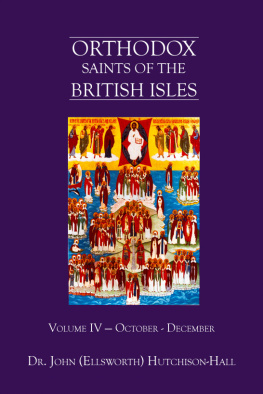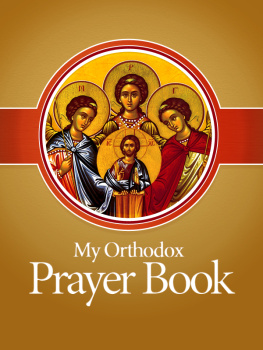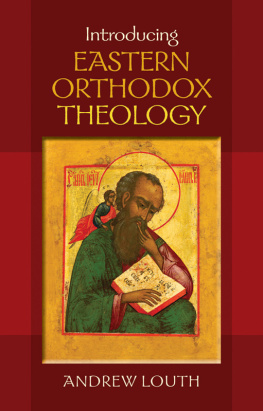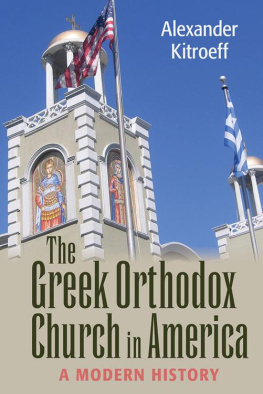St. John Maximovitch - The Orthodox Veneration of the Mother of God (Orthodox Theological Texts)
Here you can read online St. John Maximovitch - The Orthodox Veneration of the Mother of God (Orthodox Theological Texts) full text of the book (entire story) in english for free. Download pdf and epub, get meaning, cover and reviews about this ebook. year: 2012, publisher: St Herman Pr, genre: Religion. Description of the work, (preface) as well as reviews are available. Best literature library LitArk.com created for fans of good reading and offers a wide selection of genres:
Romance novel
Science fiction
Adventure
Detective
Science
History
Home and family
Prose
Art
Politics
Computer
Non-fiction
Religion
Business
Children
Humor
Choose a favorite category and find really read worthwhile books. Enjoy immersion in the world of imagination, feel the emotions of the characters or learn something new for yourself, make an fascinating discovery.

- Book:The Orthodox Veneration of the Mother of God (Orthodox Theological Texts)
- Author:
- Publisher:St Herman Pr
- Genre:
- Year:2012
- Rating:5 / 5
- Favourites:Add to favourites
- Your mark:
- 100
- 1
- 2
- 3
- 4
- 5
The Orthodox Veneration of the Mother of God (Orthodox Theological Texts): summary, description and annotation
We offer to read an annotation, description, summary or preface (depends on what the author of the book "The Orthodox Veneration of the Mother of God (Orthodox Theological Texts)" wrote himself). If you haven't found the necessary information about the book — write in the comments, we will try to find it.
The Orthodox Veneration of the Mother of God (Orthodox Theological Texts) — read online for free the complete book (whole text) full work
Below is the text of the book, divided by pages. System saving the place of the last page read, allows you to conveniently read the book "The Orthodox Veneration of the Mother of God (Orthodox Theological Texts)" online for free, without having to search again every time where you left off. Put a bookmark, and you can go to the page where you finished reading at any time.
Font size:
Interval:
Bookmark:
Orthodox Theological Texts
No. 1. The Orthodox Veneration of the Mother of God
by St. John Maximovitch
No. 2. The First-Created Man (The Sin of Adam and
Our Redemption) by St. Symeon the New Theologian
No. 3. The Place of Blessed Augustine in the Orthodox Church
by Fr. Seraphim Rose
THE ORTHODOX VENERATION
OF THE MOTHER OF GOD

Icon of St. John Maximovitch, Archbishop
and Wonderworker of Shanghai and San Francisco,
showing him holding the Cathedral of the Mother
of God Joy of All Who Sorrow in San Francisco.
Painted by Reader Vladimir Krassovsky at the time
of St. Johns glorification in 1994, this icon now
adorns the Saints reliquary in the Cathedral.

by St. John Maximovitch
Translated, with an Introduction,
by Fr. Seraphim Rose

ST. HERMAN OF ALASKA BROTHERHOOD
2012
Copyright 1978, 2012 by the St. Herman of Alaska Brotherhood
First Printing, 1978
Second Printing, 1982
Third Printing, 1987
Fourth Printing, Second Edition, 1994
Fifth Printing, 1996
Sixth Printing, Third Edition, 2004
Seventh Printing, Fourth Edition, 2012
St. Herman of Alaska Brotherhood
P. O. Box 70
Platina, California 96076
www.sainthermanpress.com
Translated from the Russian: Ieromonakh Ioann (Maksimovich), Kak Svyataya Pravoslavnaya Tserkov chtila i chit Bozhiu Mater [Hieromonk John (Maximovitch), How the Holy Orthodox Church has venerated and venerates the Mother of God]. First printed in the Orthodox Calendar for 1933 of the St. Job Brotherhood, Vladimirova, Czechoslovakia.
Front cover: Russian icon of the Mother of God Joy of All Who Sorrow, 17th-century original in the San Francisco Cathedral of the same name.
Publishers Cataloging in Publication
Maximovitch, St. John, 18961966.
The Orthodox Veneration of the Mother of God.
Translated from the Russian by Fr. Seraphim Rose.
Library of Congress Control Number: 2012930661
ISBN: 978-1-887904-26-1

The Iveron Icon of the Theotokos (9th. c.),
with its original Georgian riza. Located in the Iveron
Monastery, Mount Athos, Greece.
Commemorated February 12, October 13, and Bright Tuesday.
to the Fourth Edition
T HE AUTHOR of the present treatise on the Mother of God, Archbishop John Maximovitch (18961966), was a great hierarch and miracle-worker of our times, canonized by the Russian Orthodox Church Outside of Russia in 1994 as St. John of Shanghai and San Francisco. The translator, Hieromonk Seraphim Rose of Platina (19341982), was a disciple of St. John while the latter served as Archbishop of San Francisco and Western America during the last four years of his life.
Fr. Seraphim Rose, who became a renowned writer of the Orthodox Church, saw in St. John a living transmitter of the mind of the ancient Holy Fathers. Not wishing the English-speaking world to be deprived of the wisdom of this holy teacher, Fr. Seraphim translated many of St. Johns sermons and published them in the journal of the St. Herman Brotherhood, The Orthodox Word . In 1976, to honor the tenth anniversary of St. Johns repose, Fr. Seraphim wrote an article on the theology of St. John and presented it in The Orthodox Word together with St. Johns treatise on the Mother of God. This article by Fr. Seraphim comprises the introduction to the present book.
The original Russian version of St. Johns treatise on the Mother of God was discovered by the St. Herman Brotherhood in a rare Church Calendar that had been published by the St. Job of Fr. Seraphim found that it offered an exceptionally clear and concise treatment of a subject that often proved troublesome to Orthodox converts, especially those coming from Protestantism. In a study that was both historical and theological, St. John showed how the Church has honored the Mother of God throughout the centuries, discussed how false teachings had sought to undermine or change this veneration, and concluded with a summary of what the Church knows of the Mother of Gods earthly life.
In the introduction that follows, Fr. Seraphim writes of a young Western convert who hears a moving sermon by a Russian Abbess. The Abbess in this account is Abbess Ariadna (19001996) of the Convent of the Vladimir Mother of God in San Francisco, who had been a devoted disciple of St. John since his days in Shanghai. The young Western convert is actually Fr. Seraphim (then the young layman Eugene Rose): not wishing to exalt himself in print, Fr. Seraphim wrote of himself in the third person. His memories of St. Johns disciple, Abbess Ariadna, serve to introduce St. John himself as an authentic transmitter of the timeless mind of the Fathers to Orthodox Christians of our times.
The St. Herman Brotherhood published St. Johns treatise on the Mother of God as a separate book for the first time in 1978. On the cover Fr. Seraphim printed the Icon of the Mother of God Joy of All Who Sorrow: the patronal icon of St. Johns Cathedral in San Francisco, and one of the main icons before which he offered up fervent prayers to Her. We have placed this icon on the cover of the present edition as well, with the hope that this book will continue to bring readers into closer contact with the Mother of Godfor, as one Who intercedes with boldness before the throne of Her Divine Son, She is indeed a source of heavenly joy to all who bear their crosses in this vale of tears, on the path to eternal rejoicing in Christs Kingdom.
Hieromonk Damascene
St. Herman of Alaska Monastery, Platina, California
The Orthodox Theology of
Archbishop John Maximovitch
BY FR. SERAPHIM ROSE OF PLATINA
N OT TOO MANY years ago the Abbess of a convent of the Russian Orthodox Church Outside of Russia, a woman of righteous life, was delivering a sermon in the convent church on the feast of the Dormition of the Most Holy Mother of God. With tears she entreated her nuns and the pilgrims who had come for the feast to accept entirely and wholeheartedly what the Church hands down to us, taking such pains to preserve this tradition sacredly all these centuriesand not to choose for oneself what is important and what is dispensable; for by thinking oneself wiser than the tradition, one may end by losing the tradition. Thus, when the Church tells us in her hymns and icons that the Apostles were miraculously gathered from the ends of the earth in order to be present at the repose and burial of the Mother of God, we as Orthodox Christians are not free to deny this or reinterpret it, but must believe as the Church hands it down to us, with simplicity of heart.
A young Western convert who had learned Russian was present when this sermon was delivered. He himself had thought about this very subject, having seen icons in the traditional iconographic style depicting the Apostles being transported on clouds to behold the Dormition of the Theotokos; and he had asked himself the question: are we actually to understand this literally, as a miraculous event, or is it only a poetic way of expressing the coming together of the Apostles for this event or perhaps even an imaginative or ideal depiction of an event that never occurred in fact? (Such, indeed, are some of the questions with which Orthodox theologians occupy themselves in our days.) The words of the righteous Abbess therefore struck him to the heart, and he understood that there was something deeper to the reception and understanding of Orthodoxy than what our own mind and feelings tell us. In that instant the tradition was being handed down to him, not from books but from a living vessel which contained it; and it had to be received, not with mind or feelings only, but above all with the heart, which in this way began to receive its deeper training in Orthodoxy.
Font size:
Interval:
Bookmark:
Similar books «The Orthodox Veneration of the Mother of God (Orthodox Theological Texts)»
Look at similar books to The Orthodox Veneration of the Mother of God (Orthodox Theological Texts). We have selected literature similar in name and meaning in the hope of providing readers with more options to find new, interesting, not yet read works.
Discussion, reviews of the book The Orthodox Veneration of the Mother of God (Orthodox Theological Texts) and just readers' own opinions. Leave your comments, write what you think about the work, its meaning or the main characters. Specify what exactly you liked and what you didn't like, and why you think so.









